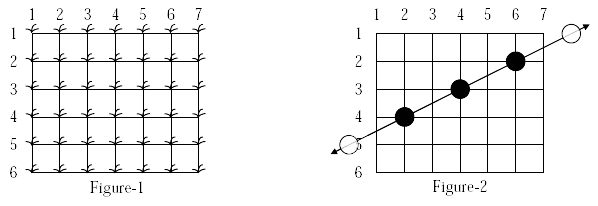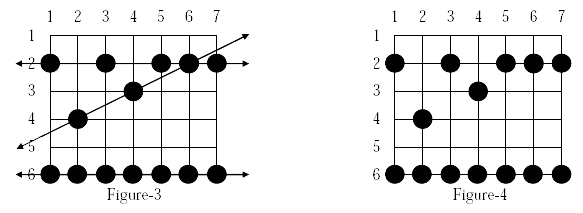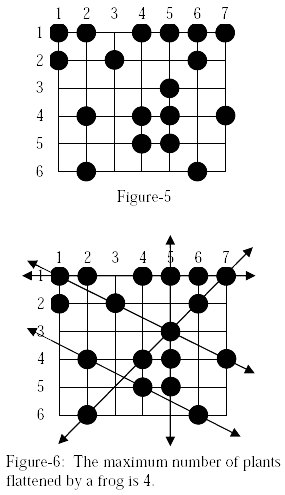IOI '02 P1 - The Troublesome Frog
View as PDFIOI '02 - Yong-In, Korea
In Korea, the naughtiness of the cheonggaeguri, a small frog, is legendary. This is a well-deserved reputation, because the frogs jump through your rice paddy at night, flattening rice plants. In the morning, after noting which plants have been flattened, you want to identify the path of the frog which did the most damage. A frog always jumps through the paddy in a straight line, with every hop the same length:

Your rice paddy has plants arranged on the intersection points of a grid as shown in Figure-1, and the troublesome frogs hop completely through your paddy, starting outside the paddy on one side and ending outside the paddy on the other side as shown in Figure-2:

Many frogs can jump through the paddy, hopping from rice plant to rice plant. Every hop lands on a plant and flattens it, as in Figure-3. Note that some plants may be landed on by more than one frog during the night. Of course, you can not see the lines showing the paths of the frogs or any of their hops outside of your paddy – for the situation in Figure-3, what you can see is shown in Figure-4:

From Figure-4, you can reconstruct all the possible paths which the
frogs may have followed across your paddy. You are only interested in
frogs which have landed on at least of your rice plants in their
voyage through the paddy. Such a path is said to be a frog path. In this
case, that means that the three paths shown in Figure-3 are frog paths
(there are also other possible frog paths). The vertical path down
column
might have been a frog path with hop length
except there are
only
plants flattened so we are not interested; and the diagonal path
including the plants on row
col.
, row
col.
, and row
col.
has
three flat plants but there is no regular hop length which could have
spaced the hops in this way while still landing on at least
plants,
and hence it is not a frog path. Note also that along the line a frog
path follows there may be additional flattened plants which do not need
to be landed on by that path (see the plant at
on the horizontal
path across row
in Figure-4), and in fact some flattened plants may
not be explained by any frog path at all.
Your task is to write a program to determine the maximum number of
landings in any single frog path (where the maximum is taken over all
possible frog paths). In Figure-4 the answer is , obtained from the
frog path across row
.
Input Specification
Your program is to read from standard input. The first line contains two
integers and
, respectively the number of rows and columns in
your rice paddy
. The second line contains the
single integer
, the number of flattened rice plants
.
Each of the remaining
lines contains two integers, the row
number
and the column number
of a flattened rice plant, separated by one blank. Each flattened
plant is only listed once.
Output Specification
Your program is to write to standard output. The output contains one
line with a single integer, the number of plants flattened along a frog
path which did the most damage if there exists at least one frog path,
otherwise, .
Sample Input 1
6 7
14
2 1
6 6
4 2
2 5
2 6
2 7
3 4
6 1
6 2
2 3
6 3
6 4
6 5
6 7Sample Output 1
7Diagram for Sample Input 1
Sample 1 corresponds to the diagrams above.
Sample Input 2
6 7
18
1 1
6 2
3 5
1 5
4 7
1 2
1 4
1 6
1 7
2 1
2 3
2 6
4 2
4 4
4 5
5 4
5 5
6 6Sample Output 2
4Diagram for Sample Input 2

Comments